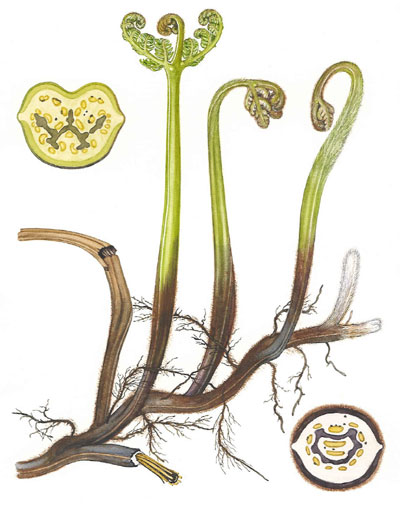|
Hardy Fern Home P. aquilinum resources All Ferns � Dennstaedtiaceae �� Pteridium
�Other Genera
|
| Pteridium aquilinum | ||
Bracken | ||
|
Etymology
Aquilinum means eaglelike.
Description
Rhizome: long-creeping, subterranean, commonly 10 cm deep, but up to 50 cm, jointed hairs.
Frond: 200 cm high by 90 cm wide, but with much variation in dimensions, deciduous, monomorphic, blade/stipe ratio: 1:1 to 2:1. Stipe: base dark brown shading to pale green above, soft hairs, vascular bundles: numerous, U- or O-shaped in cross section. Blade: 3-pinnate-pinnatifid, but variable, more and less divided, broadly triangular, large, slightly arching, papery to leathery, hairs on rachis, costae, and on lower surface of the blade, nectaries on the underside at the bases of the pinnae and costae. Pinnae: 10 to 12 pair, lowest very large, strictly opposite or subopposite in some forms; costae rachis and costae grooved above; margins folding downwards; veins free, forked, except for a marginal strand. Sori: continuous, along the margin, indusium: double, the outer false, reflexed, the inner distinct or absent, sporangia: brown, maturity: midsummer. Culture
Habitat: open, sandy, acid terrain.
Distribution: cosmopolitan, except for alpine-arctic regions.
Hardy to -35�C, USDA Zone 3.
Distinctive Characteristics
Bracken is the most studied fern, and there are many more resources on the web than listed here. It is a popular subject because of its invasive, weedy nature.
Synonyms
Pteris aquilina Linnaeus |
|
|
Notes
Subtaxa Several are recognized. None are desirable plants. Given its territory, it is likely this taxon will be split. Can two plants that won't interbreed, one from Canada, the other from Brazil, be credible members of the same species?
Subtaxa Several are recognized. None are desirable plants. Given its territory, it is likely this taxon will be split. Can two plants that won't interbreed, one from Canada, the other from Brazil, be credible members of the same species?
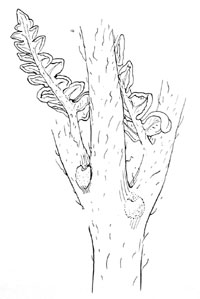
Pteridium aquilinum. Nectaries at the axils are crescent-shaped, and attract ants. �Illustration from Scandinavian Ferns by Benjamin �llgaard and Kirsten Tind, Rhodos, 1993. |
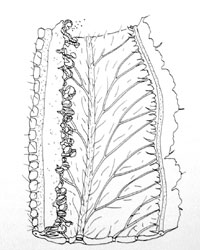
Pteridium aquilinum. Sori and venation at the ultimate segment. �Illustration from Scandinavian Ferns by Benjamin �llgaard and Kirsten Tind, Rhodos, 1993. |
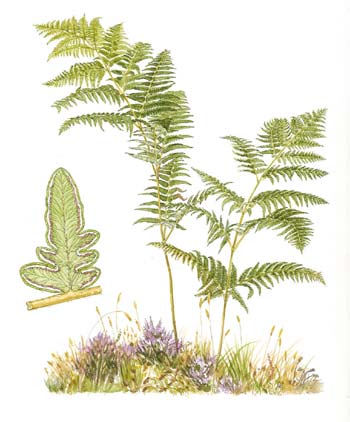
Pteridium aquilinum. Left: pinnule and marginal sori; right: in habitat, Mols, Denmark, with Calluna vulgaris, Carex arenaria, Rumex acetosella, and Jasione montana. �Illustration from Scandinavian Ferns by Benjamin �llgaard and Kirsten Tind, Rhodos, 1993. |
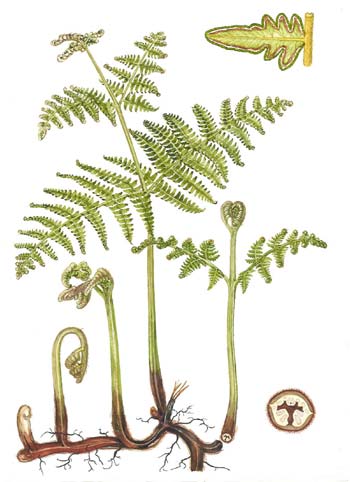
Pteridium aquilinum. Habit with rachis cross-section at lower right. The rhizome can occasionally be very deep; cases of one meter are known. �Illustration from Scandinavian Ferns by Benjamin �llgaard and Kirsten Tind, Rhodos, 1993. |
